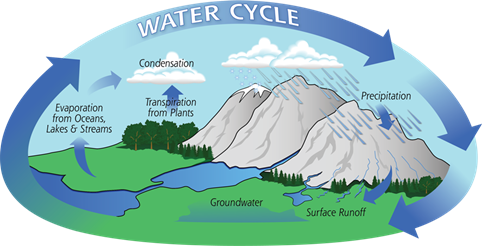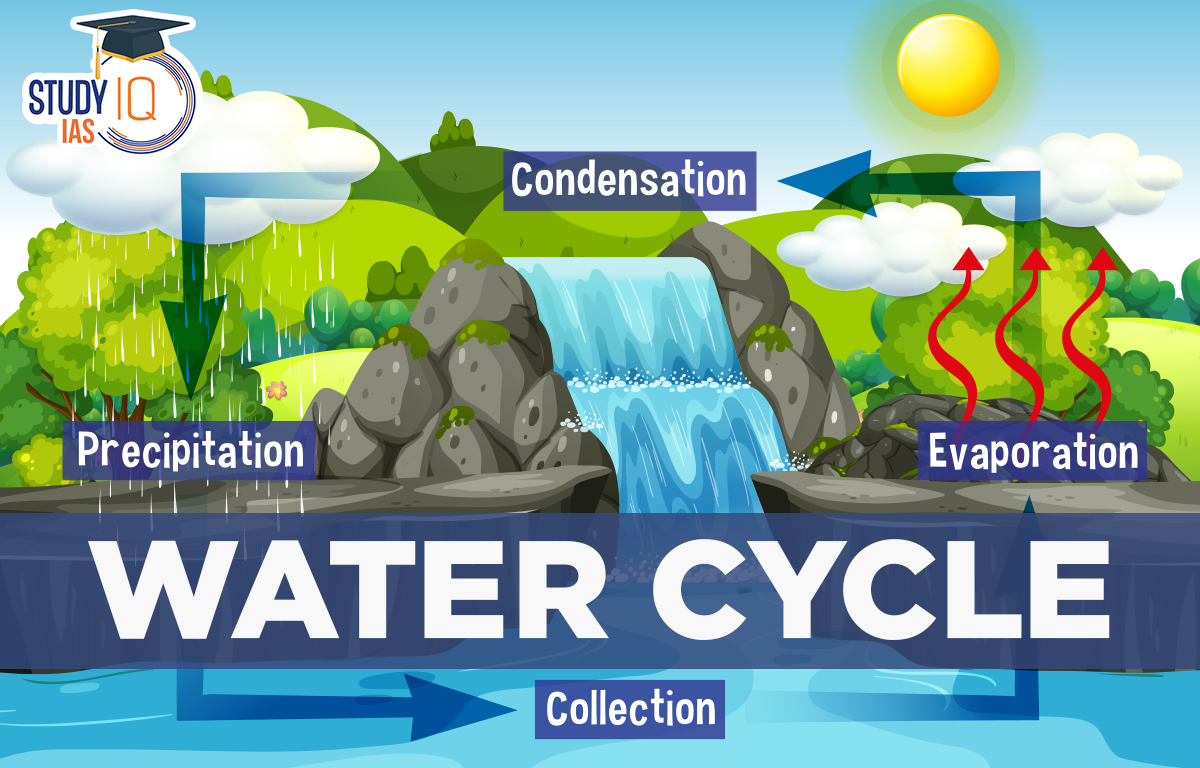Table of Contents
Context: The 2024 Global Water Monitor Report, prepared by an international team of researchers, highlights the significant effects of climate change on the Earth’s water cycle.
About Water Cycle
It is the continuous movement of water in its various forms- solid, liquid and gas – above and below the Earth’s surface.
Key Processes
- Evaporation: Water transforms into vapour due to the Sun’s heat.
- Transpiration: Plants release water vapour from the soil.
- Condensation & Precipitation: Water vapour forms clouds and falls as rain or snow.
- Return to Earth: Water enters oceans, lakes, rivers, glaciers or soil, restarting the cycle.

Importance of water cycle
- Provides water for all living organisms.
- Regulates weather patterns.
Impact of Climate Change on the Water Cycle
Amplification of the Cycle
- Rising temperatures cause more evaporation, intensifying the water cycle.
- Warmer air holds 7% more moisture for every 1°C increase in temperature.
Effects
- Increased Precipitation: Heavier rainfall over short periods, resulting in flash floods, prolonged flooding and damage to infrastructure.
- Droughts and Dry Soils: Higher temperatures cause more water to evaporate from the soil, leaving it dry. When rain eventually falls, it struggles to penetrate the hardened leading to rapid runoff instead of absorption.
- Erratic Patterns: The global water cycle becomes unpredictable as the planet warms.
Water Cycle Stages
Evaporation, transpiration, condensation, precipitation, and runoff are the fundamental five phases of the water cycle.
1. Evaporation
Evaporation is when a liquid turns into a gas. Water is the main concern in weather. For evaporation to happen, energy is needed, which can come from the sun, the ground, the air, or even people. We all experience evaporation. When we get hot, our bodies sweat, releasing water on our skin. This water evaporates using body heat, helping us cool down. It’s similar to the feeling you get after a shower or swimming.
2. Transpiration
Transpiration is when water evaporates from plants through small openings called stomata, which are found on the underside of leaves. Most of this water loss is influenced by the humidity in the air and how wet the soil is. Plants only use about 1% of the water they lose through transpiration for their growth the rest, about 99.9%, goes into the atmosphere.
3. Condensation
Condensation is the process where water vapor in the air turns into liquid. This can create clouds or dew. For condensation to happen, the air temperature must be lower than the dew point, which is the temperature at which dew forms. When the air cools to this point, it becomes saturated, and any further cooling causes water vapor to condense. Fog appears when the air temperature and dew point are the same. Condensation is the opposite of evaporation. It releases extra heat because water vapor has more energy than liquid water. This heat release can help form hurricanes.
4. Precipitation
Tiny particles in the air help create precipitation when they collide and stick together, becoming too heavy for the air to hold. This can result in rain, hail, sleet, or snow. Precipitation is the main source of fresh water on Earth. On average, the Earth gets about 38.5 inches (980 mm) of precipitation each year, both on land and in the oceans.
5. Runoff
Runoff happens when there is a lot of rain and the ground can not absorb any more water. This water flows into rivers and lakes. Most of this water goes back to the oceans and some of it evaporates into the air. If runoff only goes into a lake with no way out, the water can only leave by evaporating. As it evaporates, salts and pollutants are left behind, making the lake salty, like the Dead Sea or the Great Salt Lake. This evaporation restarts the water cycle.
Water Cycle Significance
- Helps keep temperatures from rising too much due to the greenhouse effect.
- Without its cooling effect, Earth’s temperature would significantly increase.
- Every living thing on Earth depends on it.
- Helps clean the air
- Water vapor sticks to dust particles, aiding in rain formation.
- In polluted cities, raindrops capture gases and contaminants, raindrops can also pick up tiny organisms like bacteria and leftover materials from factories.
Water Cycle UPSC
Water moves from the earth to the atmosphere and again back to the earth, completing the water cycle, which is a natural phenomenon. The water cycle involves a number of intricate processes, but it is responsible for replenishing our freshwater supplies, including rivers, lakes, and the groundwater table. The rain that the water cycle brings is also essential for plant growth, temperature regulation, and irrigation in agriculture. You will learn about the Water Cycle (Hydrologic) in this article, which will help you with the Geography and Environment syllabus preparation for the UPSC Civil Service Exam.
| Related Articles | |
| Precipitation | Evaporation and Condensation |
| Types of Clouds | Climate of India |
| Structure of the Atmosphere | Air Masses |


 LIGO Detects Most Massive Black Hole Mer...
LIGO Detects Most Massive Black Hole Mer...
 Why Is Earth Spinning Faster? Causes and...
Why Is Earth Spinning Faster? Causes and...
 Places in News for UPSC 2025 for Prelims...
Places in News for UPSC 2025 for Prelims...





















